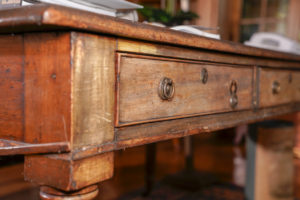 HR asked, “How do I tell WHICH era a piece of 19th century furniture, American or English, comes FROM? What are the different eras WORTH?”
HR asked, “How do I tell WHICH era a piece of 19th century furniture, American or English, comes FROM? What are the different eras WORTH?”
My answers, take each era by era. If you think it’s 19th century, is it early 19th century (1800-1830)?
HR, some clues that you DO have an early 19th century piece of furniture include: the piece has strict lines based on Classical Style (Greek and Roman design), as opposed to a more fluid, organic flowing style (think Art Nouveau style). The finish will be a honey brown, aged to perfection, if someone hasn’t taken to refinishing it.
When you slide your hand across the UNSEEN area, the bottom board of the underside of the drawer, do you feel the evidence of hand-planing by a carpenter?
HR, if you think the piece comes from the mid to late 19th century, is it mid (1840-1860) or late (1860-1900)?
Clues you have a mid to late piece of 19th century furniture:
The piece will look like a classical main street America bank building, quite rigid with a dark, imposing (deep mahogany) finish. I like to think of this as the sarcophagus period because the furniture is massy and looks like little caskets.
HR, do you think it comes from later in the 19th century?
Clues you have a late 19th century piece of furniture:
If it looks like a reproduction of an earlier period, you might have a piece of REVIVAL furniture so popular in this era. Examples are renaissance revival style furniture, and you see pieces that look like the Italian Renaissance, or the Elizabethan period revitalized. Think of the furniture at Hearst Castle.
The later period of the Victorian era looks frilly, curvy Victorian furniture, rather ginger-bready. The alternative style so popular in this period is the Eastlake or Aesthetic Movement style. You’ll see the influence of the discovery of Asian furniture. The piece has straighter lines than MOST late Victorian era furniture. A special offshoot of the Aesthetic movement turned into the Craftsman period, and from then we have Arts and Crafts, or Mission, style furniture.
Now let us look at the relative values of all the above.
Early 19th century furniture can possess value because in this period most furniture was based on styles popular with the upper classes in England, hand made in small shops on our East Coast. The attention to detail is remarkable. I consider this era a masterclass in great carpentry. Good news, this period is the most valuable period for all 19th century furniture today. Bad news, this era dropped in value about 20 years ago.
The second period, ‘sarcophagus’ looking furniture, was influenced by Napoleon’s favorite style, in France, called “Empire.” It looks very stately and severe and magisterial. I favor this era popularized in the 1980’s-1990’s in New York in the decoration of Ralph Lauren’s flagship store. Yet this period, called American Empire appears FLAT on the market today.
The next era, Renaissance Revival, absolutely does the poorest on the market today. That’s the Hearst Castle furniture. BIG and cumbersome, it presumes to be something it is NOT: GRAND.
Victorian furniture (gingerbread) also appears FLAT in the market. The prevailing style today is linear. Mid Century modern remains popular; minimalism seen as counterintuitive in a linear landscape.
The Aesthetic movement or Eastlake or Craftsman style stands moderately good on the market, but I predict these styles will rise in value again. The golden age of Mission/Craftsman happened about 25 years ago, when the Bungalow style became so popular. Barbara Streisand collected of this style, but she sold out many years ago.
Some of my clients who purchased great 19th century furniture in the 1980-1990’s can’t sell today. Many donate these pieces. But I see some reasons to purchase something from the 19th century, especially early 19th century, when you spot it in your local thrift store. This furniture is well made, completely WHOLE wood, not veneered chipboard, and it’s done all its outgassing!
Pingback: Furniture Perfect for Santa Barbara - Elizabeth Appraisals